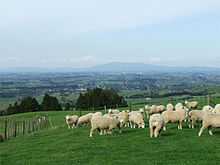Pirongia

Pirongia is a small town in the Waipa District of the Waikato region of New Zealand's North Island. It is 12 kilometres to the west of Te Awamutu, on the banks of the Waipa River, close to the foot of the 962 metre Mount Pirongia, which lies in Pirongia Forest Park to the west of the town.
Pirongia was originally named Alexandra, after the English Princess of Wales, but to avoid confusion with the town of that name in the South Island the name was changed to Pirongia. Some of the village's businesses and organisations such as the Alexandra Hotel and the Alexandra Racing Club retain the earlier name. Alexandra Racing Club, established in 1866, is reputed to be the second oldest racing club in New Zealand.[citation needed]
At the northern end of the town, between the Waipa River and the Mangapiko Stream, is the site of Matakitaki pā. This was the location of a Māori battle in May 1822 between invading musket-armed Ngāpuhi led by Hongi Hika and defending Waikato led by Pōtatau Te Wherowhero, during the musket wars.[1]
Pirongia was sited where it is because of its proximity to the Aukati (the confiscation line along the Puniu River) and because in those days this was as far up the Waipa River that river steamers, supplying the new frontier settlements, could safely travel. As a result, Pirongia (Alexandra) was planned to be the hub servicing several redoubt settlements in the area. A large settlement was envisaged and 800 town sections were surveyed. Initially, there were two military redoubts here on the east and west sides of the river. Later a third Armed Constabulary Redoubt was constructed to replace the other two. Located on Bellot Street, it is well preserved and is protected by the Historic Places Trust.
Pirongia remained of strategic importance until 1881 when King Tāwhiao and his followers symbolically laid down their arms near the intersection of Crozier and Franklin Streets and declared peace, signaling an end to the armed conflict.
Initially, the settlement prospered. In its heyday of the mid-1870s, there were two hotels, a variety of shops, a bank, a blacksmith, a lending library, a school and later a creamery, mainly on Crozier and Franklin Streets.
However, the decision to route the main trunk railway via Te Awamutu, and the resulting gradual decline in the importance of river transport, together with the dispersal from the King Country of King Tāwhiao and his followers, meant that by the 1890s, Pirongia (Alexandra) was being superseded by Te Awamutu and other settlements on the railway line. Many businesses moved to Te Awamutu or closed and the settlement gradually assumed the character of a small farming centre.
The village has experienced rapid population growth since the 1980s as city-dwellers seeking a rural lifestyle have migrated to Pirongia. This has changed the town's character from rural to suburban in a short period of time.
Pirongia has a rural fire force located in the village to protect native bush in the area. The rural fire force has a specialised off-road appliance designed for tough off-road terrain.
Pirongia is also home to the famous Pirongia Clydesdale horses regularly seen at public events throughout the countryside.[citation needed]
References
- ↑ Kelly, Leslie G. (1931). "Matakitaki pa, Pirongia". The Journal of the Polynesian Society 40 (157): 35–38.
Coordinates: 38°00′S 175°12′E / 38.000°S 175.200°E